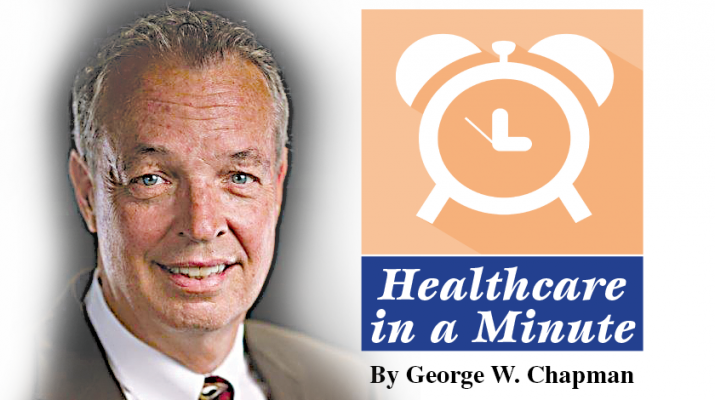By George W. Chapman
Most Trusted Profession
For the 15th year in a row, nurses are the No. 1 most trusted professionals, according to Gallup’s annual poll that ranks the honesty and ethical standards of various professionals. Healthcare providers took four of the top five spots. Following nurses are: No. 2 pharmacists, No. 3 physicians, No. 4 engineers, No. 5 dentists. Also ranking high were teachers and police officers.
2016: Some Good Health News
Colon cancer, dementia and heart disease started declining in developed countries. Since 1990, the number of women dying due to pregnancy or childbirth has declined by half. Public smoking bans have improved health in 21 countries and the number of US smokers has declines by 8.6 million since 2005. Harvard scientists are honing in on an antibiotic discovery that could help remedy the growing antibiotic resistance crisis. Homelessness has decreased in the US by 35 percent over the last 10 years. Teenage pregnancies have declined in the US for the 24th year in a row. Large oil spills declined from an average of 25 per year in the 1970s to just two a year now. Charitable donations were at an all-time high, again led by Warren Buffet at $2.9 billion and Bill Gates at $5 billion.
Hospital Mergers
In recent months, both the Federal Trade Commission and the Department of Justice have increasingly intervened to thwart or block hospital mergers. While one can only speculate what President Trump will do, there is a history of support for antitrust enforcement in healthcare from both parties. The fear is that mergers have tended to drive up costs whether in the same or separate markets. A potential merger between Catholic Health Initiatives and Dignity Health this year would create the nation’s largest system by revenue. The number of Catholic-owned or affiliated hospitals has grown by 22 percent since 2001, resulting in control of 17 percent of acute care beds in the US.
States Ranked by Health
United Health Foundation just released its America’s Health Rankings. It takes into consideration 34 measures of behaviors, community, environment, policies and clinical data like smoking, obesity, substance abuse, cardiovascular disease, etc. The five healthiest states are: No. 1 Hawaii, (five years in a row) No. 2 Massachusetts, No. 3 Connecticut, No. 4 Minnesota, No. 5 Vermont. The five unhealthiest states are: No. 50 Mississippi, No. 49 Louisiana, No. 48 Arkansas, No. 47 Alabama, No. 46 Oklahoma. It should be noted four of the five worst states are in the southeast. NYS ranked No. 13.
Choose Hospital Wisely
A study published in the academic journal “Public Library of Science” (PLOS One) found that patients cared for in the “worst” hospitals were three times more likely to die and 13 times more likely to have complications than if cared for in one of the “best” hospitals. 22 million admissions were studied, using 24 measures of medical outcomes. Researchers found significant differences among hospitals. Under terms of the agreement, in order to get hospitals to participate, the identity of the hospitals were kept confidential. In general, hospitals that treated high volumes of certain conditions fared better than those with low volumes. Most patients have little information about the differences between hospitals. The study raised the obvious question of why don’t we have broader outcomes measurement and transparency around performance available to the public.
Cost of Drugs for Seniors
The AARP Public Policy Institute reports that the price of drugs used most commonly by seniors rose more than 130 times the rate of inflation between 2006 and 2015. The average senior takes four or five different drugs every month which comes to about $26,000 annually if taking only brand name drugs. The median annual income for seniors is about $24,000. While Medicare covers some of the cost through part D, these price increases drive up Medicare premiums and the senior’s copays. Many believe congress should use the purchasing power of Medicare and Medicaid to negotiate drug prices with big pharma in order to contain spiraling drug costs.
Ontario, Canada, Healthcare
Bill 41, or The Patients First Act, is creating more controversy than our ACA because it impacts all citizens. Proponents argue it will streamline and integrate healthcare. Opponents argue it does nothing to help over-worked physicians and reduce waitlists for services (it can be several months to two years to see some specialists) and only serves to add to the already expensive and redundant bureaucracy. Unlike the US, Canada actually has “unemployed” physicians. The government controls access and expenses by restricting the number of physicians available in each of the provinces. Many of the “unemployed” physicians end up working here in the US. Once there is an “opening,” many return to Canada. On the flip side, compared to the US, the cost of care in Ontario is relatively cheap. We average about $10,000 per person in the US. The budget for 14 million people in Ontario is $50 billion. That comes to just $3,571 per person. While we are spending way too much, and with modest results, it seems that Ontario can afford to put some more physicians to work which would take some pressure off current providers and reduce the ridiculous wait lists for care. Physicians in Ontario have dubbed the bill “Bureaucracy First, Patients Last Act.”
George W. Chapman is a healthcare consultant who works with hospitals and medical groups. He operates GW Chapman Consulting based in Syracuse. Email him at
gwc@wchapmanconsulting.com.

